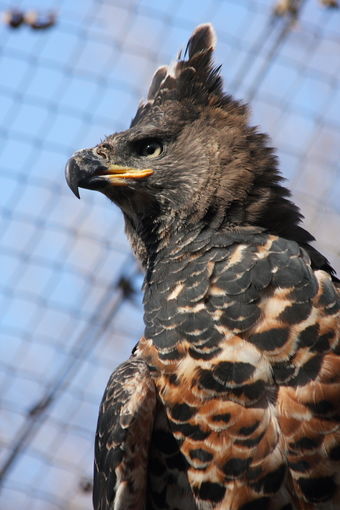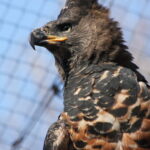The Crowned Eagle (Stephanoaetus coronatus) is a majestic bird of prey found in the tropical forests of sub-Saharan Africa. As the third-largest and most powerful African eagle, its life cycle is a fascinating study in adaptability and survival.
Nesting and Breeding
Crowned Eagles form monogamous pairs and return to the same nest year after year, preferring to build their homes in mature eucalyptus trees. Their breeding cycle is one of the most prolonged among birds, lasting approximately 500 days. This includes a 49-day incubation period, during which the female does about 80-90% of the incubation during the day, and a post-fledging period of 9-11 months.
Eggs and Incubation
Crowned Eagles typically lay up to two eggs, but often only one chick survives due to sibling rivalry and competition for food. The eggs are white or overlaid with sparse red-brown markings and measure approximately 68.2 mm x 53.6 mm (2.69 in x 2.11 in). The incubation period lasts for approximately 49 days, with the male bringing food to the incubating female every 3 to 5 days.
Hatching and Fledging
When the chick hatches, it is relatively quiet and depends on its parents for feeding. The young fledge at 90 to 115 days but remain in the care of their parents for another 11 months.
Juvenile Stage
The first two years of a juvenile Crowned Eagle’s life are particularly difficult, with many not surviving. They may resemble adults but have a barred tail and lack the distinctive crown feathers.
Adulthood
Adult Crowned Eagles are powerful predators, able to capture prey several times their own weight. They prey on various mammals, such as chevrotains, duikers, rock hyrax, small primates, reptiles, mongooses, feral cats, rats, and birds. They are also known for their loud calls, with males producing a shrill kewee-kewee-kewee sound and females a lower kooee-kooee-kooee sound.
Crowned Eagles face several threats, including habitat loss, hunting, and trapping, which have led to their classification as Near Threatened by the IUCN. Their preferred habitats, such as dense woodlands, rainforests, and indigenous forests, are being destroyed due to human activities like agriculture, mining, and timber extraction. Additionally, their size, reputation, and potential for taking small livestock make them targets for persecution, with many being shot, trapped, or having their nests destroyed.
References:
– Nature Back In – Eagles in Our Neighbourhood: The Crowned Eagle
– Critter Science – The Powerful Crowned Eagle
– Wikipedia – Crowned Eagle
– Animalia.bio – Crowned Eagle


